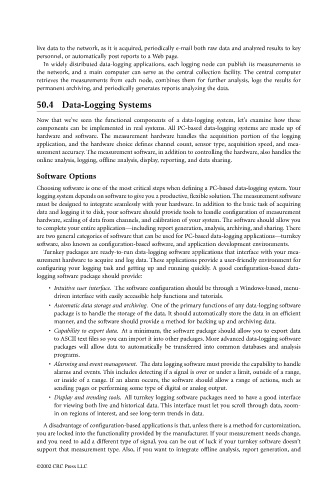Page 1232 - The Mechatronics Handbook
P. 1232
live data to the network, as it is acquired, periodically e-mail both raw data and analyzed results to key
personnel, or automatically post reports to a Web page.
In widely distributed data-logging applications, each logging node can publish its measurements to
the network, and a main computer can serve as the central collection facility. The central computer
retrieves the measurements from each node, combines them for further analysis, logs the results for
permanent archiving, and periodically generates reports analyzing the data.
50.4 Data-Logging Systems
Now that we’ve seen the functional components of a data-logging system, let’s examine how these
components can be implemented in real systems. All PC-based data-logging systems are made up of
hardware and software. The measurement hardware handles the acquisition portion of the logging
application, and the hardware choice defines channel count, sensor type, acquisition speed, and mea-
surement accuracy. The measurement software, in addition to controlling the hardware, also handles the
online analysis, logging, offline analysis, display, reporting, and data sharing.
Software Options
Choosing software is one of the most critical steps when defining a PC-based data-logging system. Your
logging system depends on software to give you a productive, flexible solution. The measurement software
must be designed to integrate seamlessly with your hardware. In addition to the basic task of acquiring
data and logging it to disk, your software should provide tools to handle configuration of measurement
hardware, scaling of data from channels, and calibration of your system. The software should allow you
to complete your entire application—including report generation, analysis, archiving, and sharing. There
are two general categories of software that can be used for PC-based data-logging applications—turnkey
software, also known as configuration-based software, and application development environments.
Turnkey packages are ready-to-run data-logging software applications that interface with your mea-
surement hardware to acquire and log data. These applications provide a user-friendly environment for
configuring your logging task and getting up and running quickly. A good configuration-based data-
logging software package should provide:
• Intuitive user interface. The software configuration should be through a Windows-based, menu-
driven interface with easily accessible help functions and tutorials.
• Automatic data storage and archiving. One of the primary functions of any data-logging software
package is to handle the storage of the data. It should automatically store the data in an efficient
manner, and the software should provide a method for backing up and archiving data.
• Capability to export data. At a minimum, the software package should allow you to export data
to ASCII text files so you can import it into other packages. More advanced data-logging software
packages will allow data to automatically be transferred into common databases and analysis
programs.
• Alarming and event management. The data logging software must provide the capability to handle
alarms and events. This includes detecting if a signal is over or under a limit, outside of a range,
or inside of a range. If an alarm occurs, the software should allow a range of actions, such as
sending pages or performing some type of digital or analog output.
• Display and trending tools. All turnkey logging software packages need to have a good interface
for viewing both live and historical data. This interface must let you scroll through data, zoom-
in on regions of interest, and see long-term trends in data.
A disadvantage of configuration-based applications is that, unless there is a method for customization,
you are locked into the functionality provided by the manufacturer. If your measurement needs change,
and you need to add a different type of signal, you can be out of luck if your turnkey software doesn’t
support that measurement type. Also, if you want to integrate offline analysis, report generation, and
©2002 CRC Press LLC

